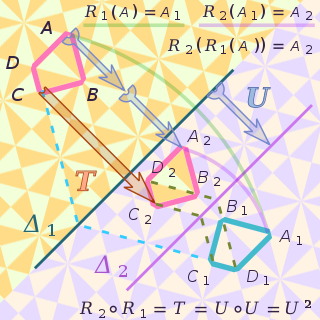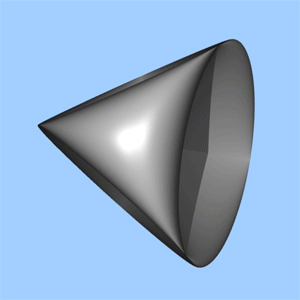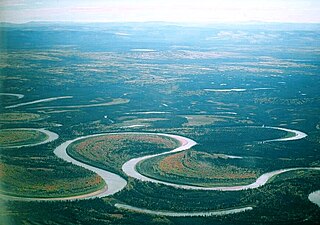 W
WRiemannian geometry is the branch of differential geometry that studies Riemannian manifolds, smooth manifolds with a Riemannian metric, i.e. with an inner product on the tangent space at each point that varies smoothly from point to point. This gives, in particular, local notions of angle, length of curves, surface area and volume. From those, some other global quantities can be derived by integrating local contributions.
 W
WThe calculus of moving surfaces (CMS) is an extension of the classical tensor calculus to deforming manifolds. Central to the CMS is the Tensorial Time Derivative whose original definition was put forth by Jacques Hadamard. It plays the role analogous to that of the covariant derivative on differential manifolds. in that it produces a tensor when applied to a tensor.
 W
WIn mathematics, a conformal map is a function that locally preserves angles, but not necessarily lengths.
 W
WIn multilinear algebra and tensor analysis, covariance and contravariance describe how the quantitative description of certain geometric or physical entities changes with a change of basis.
 W
WCurved space often refers to a spatial geometry which is not "flat", where a flat space is described by Euclidean geometry. Curved spaces can generally be described by Riemannian geometry though some simple cases can be described in other ways. Curved spaces play an essential role in general relativity, where gravity is often visualized as curved space. The Friedmann-Lemaître-Robertson-Walker metric is a curved metric which forms the current foundation for the description of the expansion of space and shape of the universe.
 W
WIn Riemannian geometry, an exponential map is a map from a subset of a tangent space TpM of a Riemannian manifold M to M itself. The (pseudo) Riemannian metric determines a canonical affine connection, and the exponential map of the (pseudo) Riemannian manifold is given by the exponential map of this connection.
 W
WPaul Gauduchon is a French mathematician, known for his work in the field of differential geometry. He is particularly known for his introduction of Gauduchon metrics in hermitian geometry. His textbook on spectral geometry, written with Marcel Berger and Edmond Mazet, is a standard reference in the field.
 W
WA great circle, also known as an orthodrome, of a sphere is the intersection of the sphere and a plane that passes through the center point of the sphere. A great circle is the largest circle that can be drawn on any given sphere. Any diameter of any great circle coincides with a diameter of the sphere, and therefore all great circles have the same center and circumference as each other. This special case of a circle of a sphere is in opposition to a small circle, that is, the intersection of the sphere and a plane that does not pass through the center. Every circle in Euclidean 3-space is a great circle of exactly one sphere.
 W
WIn mathematics, a Hermitian symmetric space is a Hermitian manifold which at every point has an inversion symmetry preserving the Hermitian structure. First studied by Élie Cartan, they form a natural generalization of the notion of Riemannian symmetric space from real manifolds to complex manifolds.
 W
WIn mathematics, an isometry is a distance-preserving transformation between metric spaces, usually assumed to be bijective.
 W
WIn differential geometry, Loewner's torus inequality is an inequality due to Charles Loewner. It relates the systole and the area of an arbitrary Riemannian metric on the 2-torus.
 W
WMetric Structures for Riemannian and Non-Riemannian Spaces is a book in geometry by Mikhail Gromov. It was originally published in French in 1981 under the title Structures métriques pour les variétés riemanniennes, by CEDIC (Paris).
 W
WIn geometry, parallel transport is a way of transporting geometrical data along smooth curves in a manifold. If the manifold is equipped with an affine connection, then this connection allows one to transport vectors of the manifold along curves so that they stay parallel with respect to the connection.
 W
WIn differential geometry, Pu's inequality, proved by Pao Ming Pu, relates the area of an arbitrary Riemannian surface homeomorphic to the real projective plane with the lengths of the closed curves contained in it.
 W
WIn the mathematical field of differential geometry, the Riemann curvature tensor or Riemann–Christoffel tensor is the most common way used to express the curvature of Riemannian manifolds. It assigns a tensor to each point of a Riemannian manifold, that measures the extent to which the metric tensor is not locally isometric to that of Euclidean space. The curvature tensor can also be defined for any pseudo-Riemannian manifold, or indeed any manifold equipped with an affine connection.
 W
WIn metric space theory and Riemannian geometry, the Riemannian circle is a great circle equipped with its great-circle distance. It is the circle equipped with its intrinsic Riemannian metric of a compact one-dimensional manifold of total length 2π, or the extrinsic metric obtained by restriction of the intrinsic metric on the sphere, as opposed to the extrinsic metric obtained by restriction of the Euclidean metric to the unit circle in the plane. Thus, the distance between a pair of points is defined to be the length of the shorter of the two arcs into which the circle is partitioned by the two points.
 W
WIn mathematics, a symmetric space is a pseudo-Riemannian manifold whose group of symmetries contains an inversion symmetry about every point. This can be studied with the tools of Riemannian geometry, leading to consequences in the theory of holonomy; or algebraically through Lie theory, which allowed Cartan to give a complete classification. Symmetric spaces commonly occur in differential geometry, representation theory and harmonic analysis.
 W
WGauss's Theorema Egregium is a major result of differential geometry that concerns the curvature of surfaces. The theorem is that Gaussian curvature can be determined entirely by measuring angles, distances and their rates on a surface, without reference to the particular manner in which the surface is embedded in the ambient 3-dimensional Euclidean space. In other words, the Gaussian curvature of a surface does not change if one bends the surface without stretching it. Thus the Gaussian curvature is an intrinsic invariant of a surface.
 W
WTortuosity is a property of a curve being tortuous. There have been several attempts to quantify this property. Tortuosity is commonly used to describe diffusion and fluid flow in porous media, such as soils and snow.